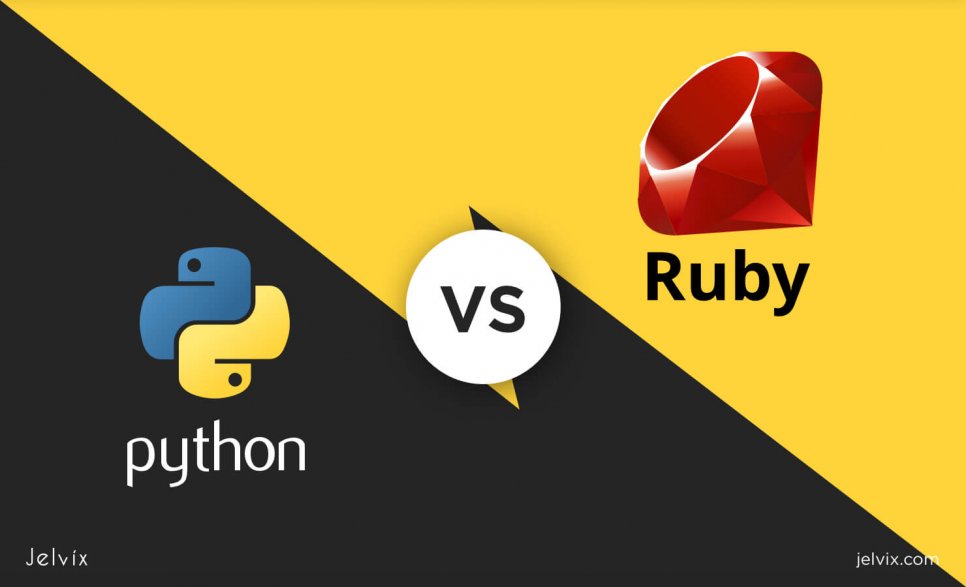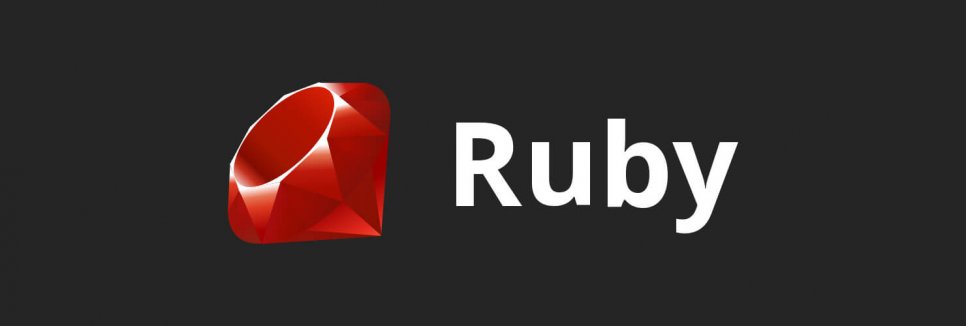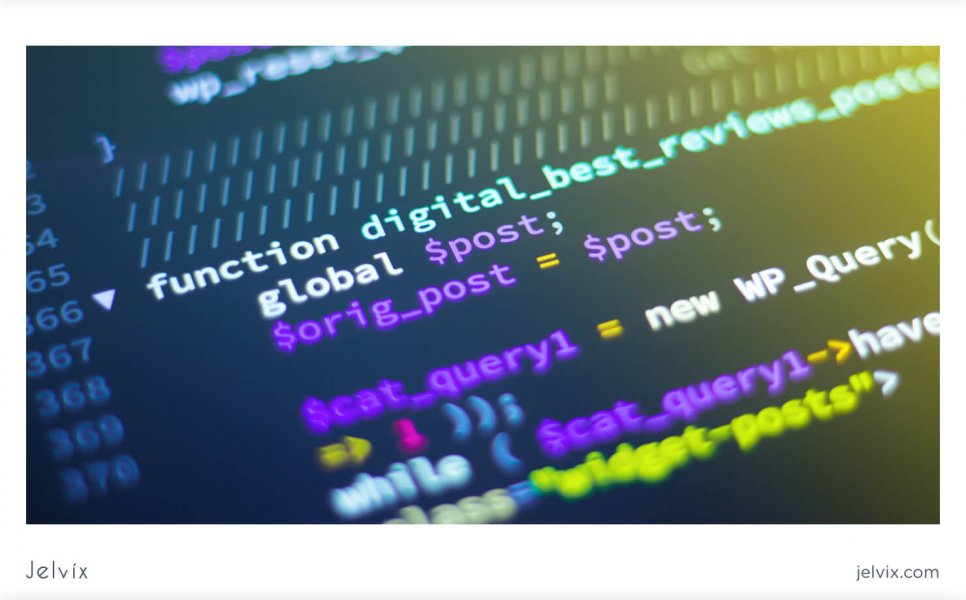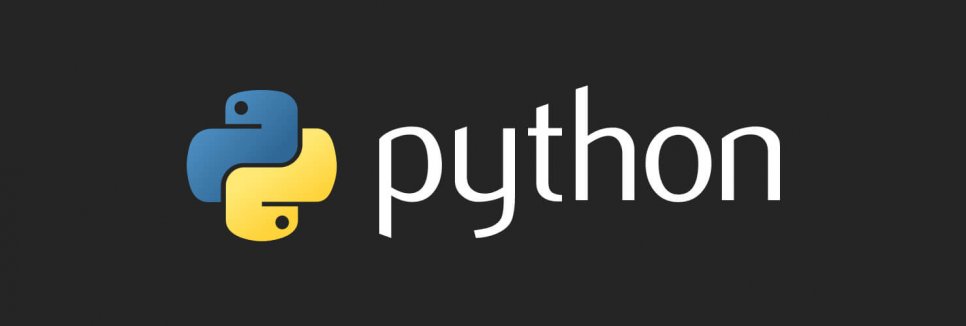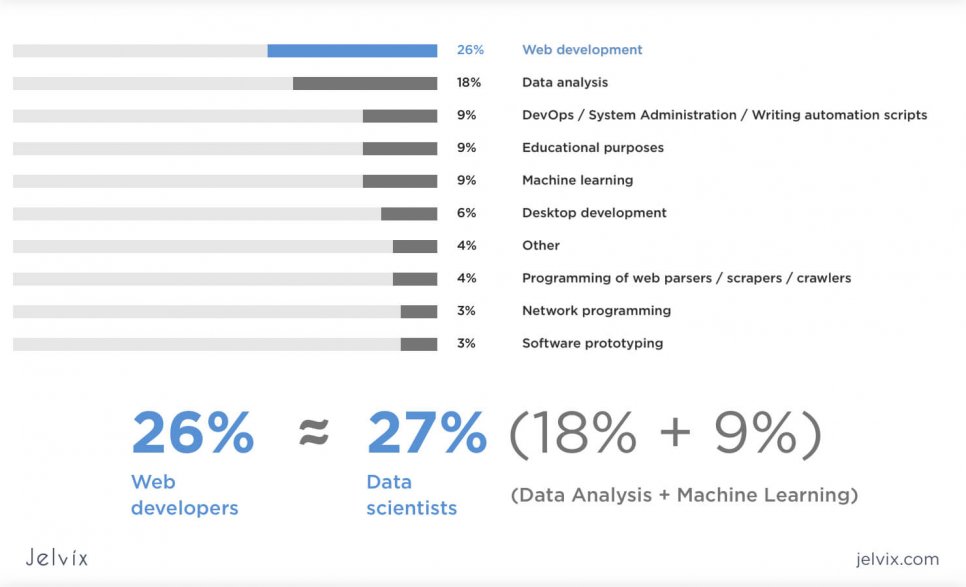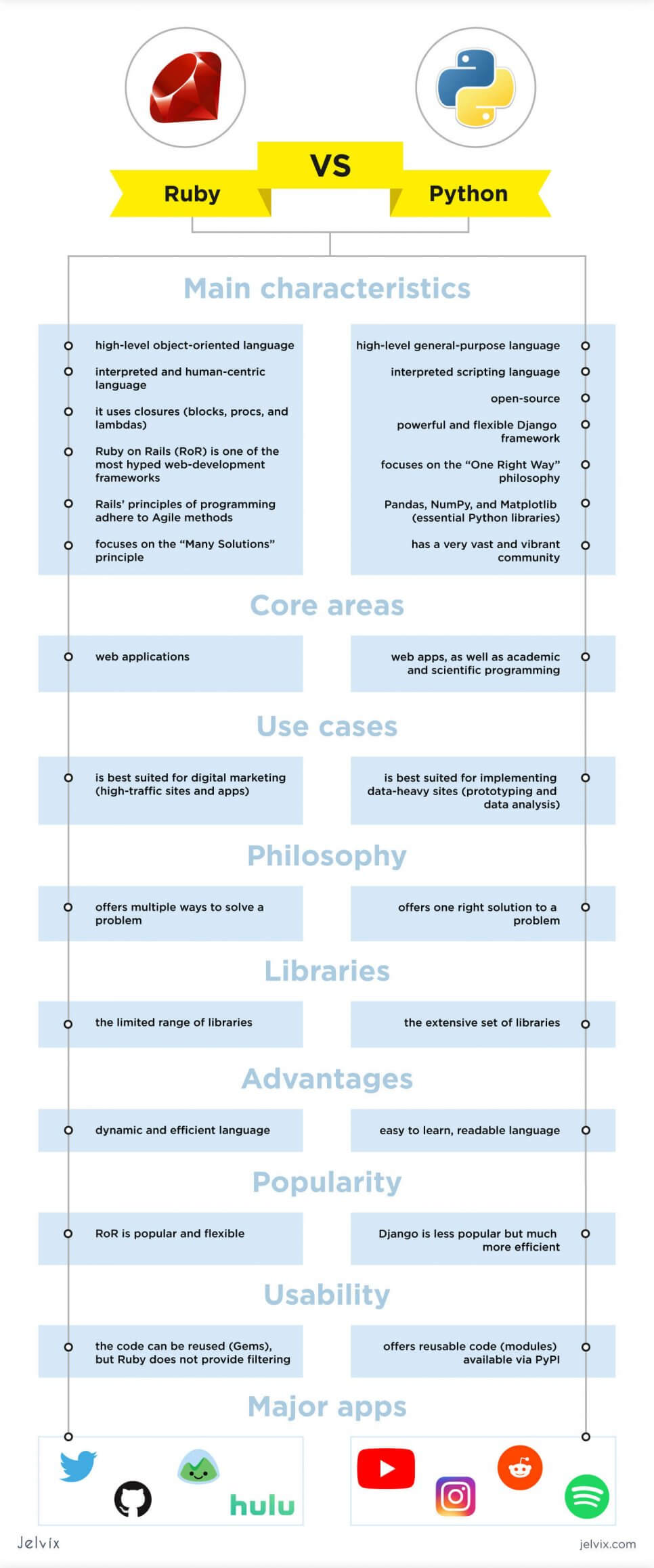Today’s web development is primarily dominated by all-purpose languages that compile to high-performance code. There are around 600 languages out there, but not all of them get a good rap. In this guide, we will learn about the two most popular languages in programming: Ruby vs Python.
All languages are built on similar types, however, they support multiple programming styles; there are medium languages which are closer to the machine, and high-level languages that have high-level abstraction from the original code run on the computer’s CPU.
A high-level language uses natural elements to create efficient programs that are much easier to execute than a low-level language; it focuses more on programming logic and is usually independent of the hardware architecture.
Not so long ago, JavaScript and .NET were the hottest languages, but as the programming world is evolving, we tend to update ourselves too with new-generation high-level languages – Ruby and Python. At Jelvix, we strive to use the best technology that suits the client’s business needs.
Need a partner with Ruby development company dedicated to understanding your business challenges? Jelvix helps you determine the technology stack and the perfect framework to help you get moving fast.
Ruby vs Python: Brief Overview
Both languages were developed in the mid-’90s as side projects, and quickly became the most popular languages used in coding.
Python is an Interpreted Language which emphasizes readability and lets you code small tasks very quickly. Unlike Java or C/C#, this one doesn’t discourage you from getting involved in complex structures. Python is considered a beginner-friendly language; it focuses on the philosophy that “there is only one best way to do something,” which, of course, seems a strict limitation of freedom to Ruby proponents. Very often, this philosophical approach is often referred to as Pythonic. The principle behind Pythonic coding is to encourage a large number of idioms to accomplish a number of tasks; such a regimented approach results in Python being the most demanded language to learn.
In contrast, Ruby stresses the importance of having many solutions to achieve your objective effectively. Also, Ruby is a bit harder to learn as it incorporates more syntax rules and other programming conventions. But from the very beginning, both Ruby and Python were intended to implement complex web apps and sites that will run on all types of platforms like Windows, macOS, and Linux. In the next chapters, we are going to learn about each languages’ features and compare them.
Ruby
The creation of Ruby was influenced by its developer’s favorite languages: Perl, Smalltalk, Ada, and Lisp. Back in 1995, Yukihiro Matsumoto, also known as Matz, had no idea Ruby would succeed; it was originally released as an “Object-Oriented Scripting language,” but later gradually evolved as a high-level, general-purpose programming language. Today, Ruby is used for developing architecturally clean web applications and sites as it simplifies common low-level tasks and focuses on developer’s productivity; its primary goal is to combine functional and imperative programming styles to make software development easier.
As mentioned, Ruby has “borrowed” Perl’s programming motto about the idea of having many solutions to the problem. This means that Ruby devs will always have a variety of ways to deal with troubleshooting effectively. Ruby can also be characterized as clear and effective; it’s famous “HELLO WORLD!” program was first to be used for testing systems. The program is known as the classic and time-honored way to learn to program and serves as a great indicator of Ruby’s “human” natural code.
Ruby’s popular web-application framework called Ruby on Rails (RoR) is the primary reason why developers consider this language for web development. This open-source server-side framework is built on the modern-view-controller (MVC) pattern and is used by almost a million sites globally. RoR consists of excellent tooling, in-built functions, and libraries so that programmers don’t have to build applications from scratch. Prominent among these is a relatively fresh approach to developing web applications, which is known as a design paradigm; the paradigm removes the need for typing boilerplate code manually. “Convention over Configuration” best expresses Rails’ philosophy of adopting a series of sensible assumptions, which frees programmers from configuring every single detail of their app.
Another principle of RoR is called YAGNI. The basic idea underlying this principle is the importance of implementing features that are needed NOW and avoiding writing the code for features that will be necessary for the future. Following YAGNI philosophy, programmers are able to focus on the business requirements and maintain a flexible application.
Both principles are fundamental for Rails’ philosophy of web development, and enforced by many developers using Rails.
Famous pages built with Rails: Basecamp, Airbnb, GitHub, Shopify, Goodreads, Hulu, Twitch, and UrbanDictionary.
The list below summarizes Ruby’s main characteristics:
- high-level object-oriented language;
- interpreted and human-centric language;
- uses closures (blocks, procs, and lambdas);
- Ruby on Rails (RoR) is one of the most hyped web-development frameworks;
- Rails’ principles of programming adhere to Agile methods;
- focuses on the “Many Solutions” principle;
Python
Python is a top pick as one of the most popular languages used for academic and scientific computing; the language encompasses a set of statistical libraries used for data science and machine learning. According to the JetBrains report, the adoption of Python in the scientific industry has increased significantly since the early 2000s. Consequently, it has become widely used for developing artificial intelligence apps. For exploratory computing and data visualization, Python has also improved its libraries (TensorFlow, Pytorch, and Theano), boosting its support in AI.
Named for Monty Python, it was originally created as a scripting language to bridge the gap between the shell and C; today, it is a general-purpose cross-platform language that is available under FSF and OSI licenses. Further, Python is an interpreted language, which means that its code is not actually translated to a machine-readable format at runtime.
Python was first released in 1991 by Guido van Rossum with the purpose to replace BASIC and Pascal; it deals globally with the basic postulate that code readability is one of the most crucial qualities of a good code. In comparison to Ruby’s inherited philosophy, Many Is Better Than One, Python follows an approach called “Zen of Python.” The motto is represented by a list of numerous mantras that indicate the fundamental concept of Python programming. And so, at the core of these guiding principles presuppose the concept diametrically opposite to the one represented by Ruby: There Is Only One Best Way To Do Something. Other remarkable implications are Simple Is Better Than Complex and Namespaces Are One Honking Great Idea.
Another significant feature of Python is White Space. By virtue of White spacing, Python delimits keywords and names, which, in turn, results in human-readable and easy language. As we have mentioned, readability is extremely crucial to Python’s syntactic principles, and this feature plays a critical role in explicit Python parsing.
Python’s famous framework called Django has become especially popular in recent years and is widely used by large organizations, such as the Washington Post, National Geographic, and OpenStack. Just like Rails, the framework is built on the MVC architecture pattern, but with a new twist. It’s called Model-Template-View. Django prefers to use its own programmed logic, and handles the Controller part itself; The Template is used to handle user interface, and manage tools that make working with data sources much easier. In other words, the framework provides a designer-friendly plain-text template system which allows coders to deploy system changes rapidly, and control what should be displayed and how.
Famous pages built with Python are Google, YouTube, Instagram, Spotify, Reddit, Dropbox, Yahoo, and Quora.
We have united all of the above characteristics into the list below:
- high-level, general-purpose language;
- best used for creating data-heavy websites and scientific apps;
- interpreted scripting language;
- easy to learn, readable and straightforward;
- open-source;
- powerful and flexible Django framework;
- focuses on the “One Right Way” philosophy;
- Pandas, NumPy, and Matplotlib (essential Python libraries);
- has a very vast and vibrant community.
Ruby vs Python: The major differences
When differentiating Ruby and Python, the first thing that comes to mind is their code-level difference. Ruby is an object-oriented language, whereas Python has both primitive types and objects. Python uses a lot of internal functions and has a richer set of data structures, while Ruby has only closures that have to be wrapped in the form of procs to pass them; closures can be defined using blocks, and retain the full access in the scope they were created in. Further, Python’s approach to namespacing is to define the scope and to give each file its own namespace; on the other hand, Ruby uses a squish method which helps to group multiple white spaces to a single space. Finally, Python’s code can be reused and is presented in the form of independent modules that are easy to filter and choose from. Although Ruby’s code also has the reuse mechanisms (you can reuse it through inheritance), this is a very complicated and sometimes even painful process: if used incorrectly, it may erode most of the object-oriented design benefits.
Apart from differences in the code structure, the languages also have usage and purpose differences. Ruby is common for creating web applications quickly, while Python is mostly used for developing more complex and time-taking projects. In addition, Ruby has a limited set of libraries, which makes the language way too narrow-profile. On the contrary, Python offers a wide range of libraries that can be used by students, data scientists, etc. for various non-marketing purposes. Ruby is considered to be more flexible since its programming approach allows the decision-maker to define multiple solutions to perform the task, whereas Python is associated with a more strict decision-making style.
Last but not least, let us introduce the major differences between languages’ frameworks. There is actually a number of other frameworks, but these two have proved to be the most outstanding ones. Both RoR and Django act as an ORM and help the developer actually create something. However, when it comes to rapid development, Ruby on Rails appears to be in the highest demand, compared to Django. This is due to the fact that Django is a bit more advanced, and hence, more difficult to apprehend. Specifically, it comprises a large number of materials and data, which may seem relatively easy, providing that you are a Python expert; however, for a beginner, the framework is very hard to approach. With RoR’s emphasis on convention, you really get a lot of things (like extensive code generation and server-side metaprogramming) that you don’t have to manually set. This is a great advantage in terms of development efficiency because it lessens the amount of work for the coder and gives the ability to build compelling products quicker.
Another reason for RoR’s wide industry usage is the size of Ruby’s community. Accordingly, Ruby’s user base is very young, meaning that everyone who uses Ruby will encounter Rails, anyway. On the contrary, Python’s community is known to be very large and comprehensive, and there are people who have no experience using Django.
The table below summarizes the above-mentioned differences between Ruby and Python.
Which is better to learn first, Ruby or Python?
Both Ruby and Python offer excellent frameworks, have vital communities, and are widely used in web application development. Python is the obvious choice for developing complex database-driven applications, whereas Ruby is perfect for startups – from small websites to large-scale social networks. However, we tend to have a collective conclusion that Python is more transparent and easy to grasp, at least from the learning perspective. Python is often compared to Standard English – as it magically transforms syntactic combinations into code. Even though it may seem complicated at first, it has attained the status of being the easiest programming language to learn first. Although Rails framework is regarded as one of the top best frameworks for creating web applications, and Ruby’s community makes it an ideal environment for creating products and services for companies worldwide, you won’t be able to master the framework without Python programming skills; Python language will be the best for you to learn the basics (if you are new to programming) as it has a simple syntax and a large standard library.
In any case, statistics show a significant increase in data science jobs, meaning that learning Python is very actual for anyone involved in programming, as it is more suitable for scientific computing and data science.
Nevertheless, we believe that all languages share the same strengths and weaknesses, and it would be unwise to give preference to more conventional languages and ignore complex ones. Every code is unique and has its own variables, procedures, and functions; in order to keep up with the latest developments in the field, it is better if you learn as many languages as possible.
As you may have understood, the Jelvix environment is very special – only people with exceptional skills will be comfortable in it. Our specialists have the necessary industry knowledge that helps us develop a wide range of specific solutions when it comes to managing software implementation projects. In particular, the Jelvix team consists of creative devs with firm experience in Data Science, Big Data, Machine Learning, and AI, and UX/UI design. With the global network of full-stack front-end developers, we can provide you with the ideal solution for your special business needs.
Need a certain developer?
Access top talent pool to reach new business objectives.



